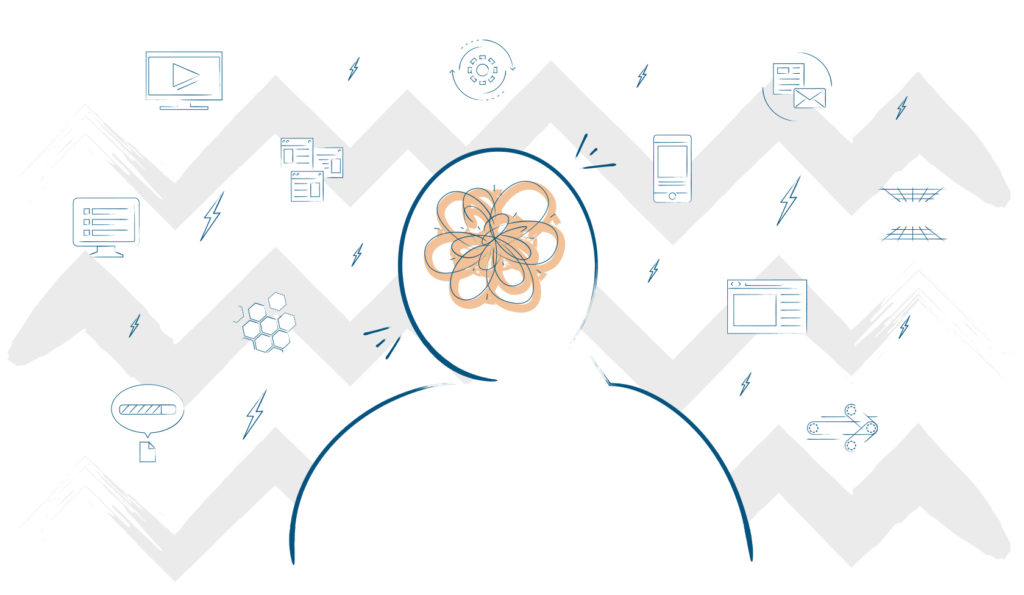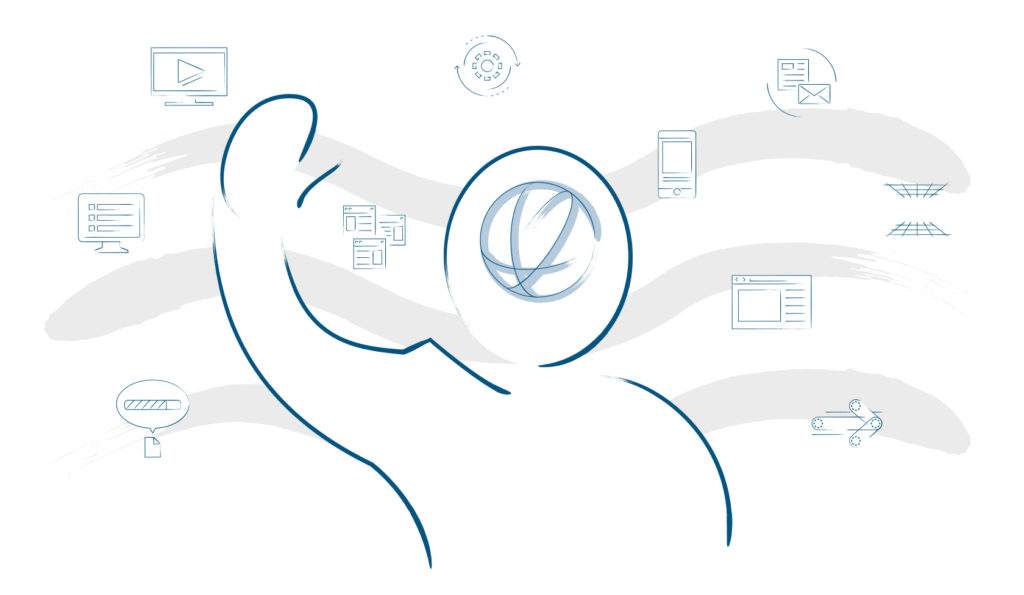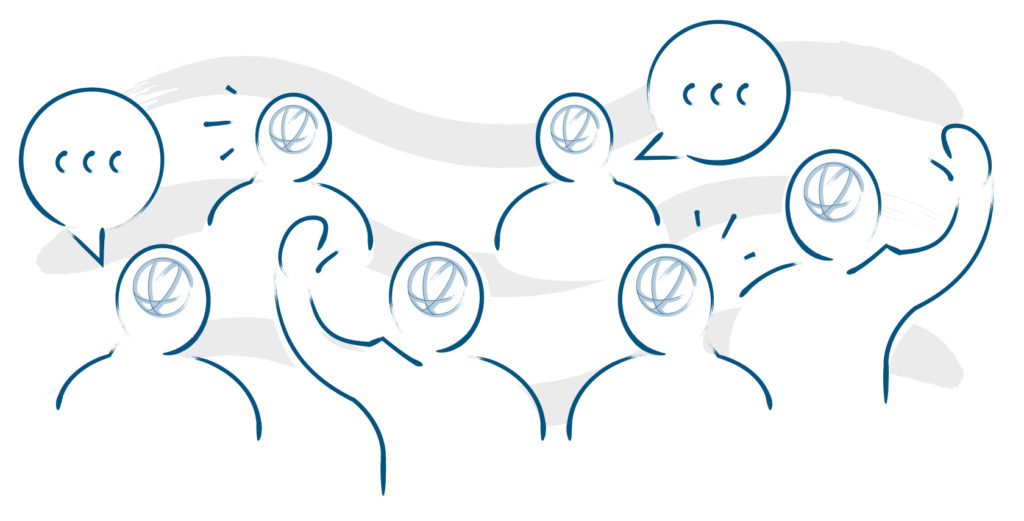As technologies advance, so does the complexity of the world in which business leaders must operate. That’s the promise and challenge of digital transformation.
That said, while many industries are increasingly exhibiting signs of VUCA, these changes are not happening all at once or at the same rate. The transition to digitally transformed business models varies across industries and portfolios. Media & entertainment and retail have changed dramatically due to the acceleration of ecommerce thanks to Amazon and content creators like Netflix. Compare that to inherently physical industries such as consumer packaged goods and the automotive sector, which are seeing much more modest impacts due to digital shifts.
One thing’s for certain: at the highest level, change unlike anything we have ever seen is coming. With digital transformation, the question for leadership teams isn’t, “Is this happening?” but, “How urgently do we need to shift to be prepared for the digital world?”

How should leadership adapt for the 21st century?
Leaders need to become better at calibrating and adapting how they lead based on the scenario or circumstance at hand.
That’s not to say leaders must unlearn everything. There are and will continue to be challenges that require efficient, top-down hierarchy in order to produce meaningful value. (For simplicity, let’s call this 20th century leadership.) Aspects of the organization that deal with high knowledge contexts will require the best skills that leaders learned in decades past:
- Mastering the known (and being known for what you know)
- Producing efficiently
- Distributing resources widely
- Maximizing what was gotten out of those resources
Yet, for 21st century challenges, there is little to no precedent. Leaders will need to be able to “toggle out” of old patterns and approach the challenge alongside their teams as humble learners. It’s not that 21st century thinking is better; it just happens to be undervalued in a majority of today’s organizations. Investing in talent that delivers on efficiency and the status quo continues to be a much higher priority for many organizations. Unfortunately, that sort of talent strategy leads to bankrupting the organization of talent with the potential to be 21st century leaders.
The 4-1-1 on adaptive leadership
This concept of calibrating and adapting a leadership style to different types of knowledge circumstances is also not new. In The Practice of Adaptive Leadership, the authors describe a theory of personal and organizational change where two types of challenges can be anticipated: adaptive and technical. Technical challenges have clearly defined problems that are straightforward to resolve with the expert input. Adaptive challenges require new learning on the part of team members at all levels in order to make sense of the problem and the path to a solution.
Here’s what all of this means: There is opportunity to dive more deeply not only into the exact types of adaptive challenges that are in front of leaders during digital transformation, but also into how they can develop and grow on their adaptive journeys to be ready for an increasingly digital world. Keep reading to explore five adaptive windows that leaders will need to apply to a mix of leadership skills in order to make sense of the past as well as navigate the uncertain future.

1. Intelligence becomes collaborative
It’s difficult to imagine the future without discussing the role that advances in technology will play—both in driving technological progress forward and in disrupting the state of the workforce. Today’s low-skilled roles that require little to no creativity will likely be co-opted by machines. But that doesn’t have to spell doom for employees.
For example, because AT&T had sole rights to the iPhone when it launched in 2008, the company had a head start for providing enterprise data infrastructure solutions. As such, the company made a strategic shift away from mobile and landlines, which also meant obsoleting potentially thousands of field technicians and repairmen. The solution was to upskill the workforce.
AT&T’s learning and development function partnered with Udacity and Georgia Tech to create an online master’s in computer science for their employees. The message was clear: upskill or make yourself redundant.
Not all firms will take this approach to adapting to the future while still maintaining the roots of the past, but it will take creative solutions like this to prepare firms for the long-term uncertain future. Machines can extend and augment the human workforce by boosting our individual analytical and decision-making capacity, enabling more personal and diverse forms of employee and customer interactions, and extending what we can do physically on factory floors.
Redesigning organizational dynamics at the human-machine interface is entirely new territory for most organizations. It will require a number of mindset shifts for leaders:
- First, to prioritize the digital opportunity
- Second, to set the vision and path forward
- Third, to follow through with the execution
2. Companies become causes
Social movements have digitized, and with them the digital identity of some of our most loved and reviled brands. Today’s leaders will need to navigate cases like Uber where, in the midst of tremendous business success, the firm was also navigating a deeply entrenched culture of corporate misbehavior and sexual harassment. In the same year that Uber’s improprieties reached the national stage, a contentious memo released by a Google engineer argued that women were less suited to engineering than men. These two corporate examples were just some of many that added fuel to the #metoo movement already underway.
Companies are having to make decisions about how they want to be perceived as an identity with its own opinions about social justice and ethics. For example, Nike responded to protests in the NFL (and the ensuing backlash) by running prime time television ads that clearly stated, “We stand with you.”
Leadership teams will continue to have to adapt to these circumstances and ask, “Why do we matter? Who are we impacting? What do we stand for and against?” Not asking these questions means risking losing out on a rapidly growing millennial market that craves personal connections to mission- and purpose-oriented brands.
3. Mainstreams meet the margins
Inherently connected to the movements described above are the topics of inclusion and diversity that underpin them. Homogeneity is no longer a predictor of success but rather a risk. Issues of age, gender, race, religion, and sexual orientation are no longer taboo topics for the workplace.
While diversity and inclusion continue to be issues of compliance and are seen by many as a “nice to have,” recent research has demonstrated that diverse organizations represent a market opportunity with clear links to the bottom line:
- They consistently outperform peers in their industry.
- They produce high-performing teams that are more innovative, engaged, and creative in their work.
- They can generate up to 30% higher revenue per employee and increased profitability.
It is by successfully integrating those minorities who are at the margins of our organizations (and the communities we do business in) that tomorrow’s leaders will find differentiated success in producing engaged and innovative workforces. Rather than asking “Does this person ‘fit’ into our culture?” (thus reinforcing an existing opinion about what the right, average person is to recruit into an inherently biased culture), leaders must adapt and open up to the question of “What might this person add to our culture?”
4. Boundaries begin to blur
Organizations are becoming increasingly global and remote. Technology is enabling our workforces to span every time zone on the planet, and yet even when teams are located in the same city, teleconference calls are prevalent thanks to flexible “work from home” policies.
Retirement at 66, working in the office, single-income households, full-time vs part-time—these boundaries of where work begins and ends were at one point considered sacrosanct. Now these traditional lines are blurring. Where “official guidance” might be set, HR and people managers will increasingly need to handle circumstances without precedent. A 20th century leader might be inclined to rein things in and create a streamlined policy that is efficient and productivity focused, but what we know about productivity is changing.
The blurring of boundaries also extends to an organization’s competition, consumers, and suppliers.
Competition used to come from only within an industry, but digital solutions are making it possible for the likes of Amazon (retail) and Google (advertising) to compete in fields such as healthcare. Even the definitions of customer and consumer to include digital fans, influencers, and ambassadors. Finally, our relationships with suppliers and vendors is evolving. As digital comparison platforms become more prevalent, there is an increasing focus on building relationships with symbiotic interests. Just shy of integrations and acquisitions, firms and their supply chains are becoming increasingly integrated to keep up with the pace and variety of global demand.
To manage this world of blurred boundaries, leaders will need to find a happy medium between control and freedom. For every firm and every office, leaders will need to factor in the unique nuances of culture, workforce demographics, and industry trends to avoid creating a dissonant experience for employees that is contextually out of place.
5. Curiosity cultivated as a renewable resource
Curiosity is a character trait that conventional wisdom would tell us directly conflicts with efficiency. How can we efficiently approach a problem if we are constantly questioning what we are doing? It’s this mindset toward curiosity that has been one of the major barriers to promoting curiosity in the workplace, with about two-thirds of employees saying they feel “unable to ask a question at work.”
The limiting belief is that, if curiosity is encouraged, management would be more difficult, disagreements would arise, and decisions would be difficult to agree on. While it is true that curiosity does involve questioning the status quo, it also implies not settling for the first answer we arrive at. This is the exact type of learning mindset that will be required of leaders at all levels as the tough, complex, and ambiguous problems of digital transformation become more prevalent.
Recent research supports this premise, demonstrating that increased curious behaviors led to reduced group conflict, more open communication and team performance, fewer decision-making errors, and more innovation and positive change in creative and non-creative jobs.

Activating adaptive leaders
With these five adaptive windows in mind, how can organizations develop and prepare their top performers to navigate this uncertain world? Adaptive leadership and the new skills of the 21st century leader will require interaction, contextual scenario, and role play in order for the lessons to come alive and for mastery to be cultivated. Here are some things to keep in mind:
Craft scenarios, not slides. Strengths such as empathy or emotional intelligence aren’t necessarily learned in a traditional classroom setting. Person-to-person interactions and immersive scenarios are the richest source of insight for the relational skills needed to explore a leader’s adaptive style.
Teach through networks, not classes. Reid Hoffman, co-founder of LinkedIn, believes all leaders should become “infinite learners” who cultivate a “personal learning cloud.” He argues that, to keep pace with change, sources of learning cannot come from a catalogue but rather must come from a human network. Adaptive leaders will need to tap into their networks and develop relationships to solve very specific challenges and navigate situations.
Embrace the crowd, not control. The future of learning is on-demand, asynchronous, and on the go. (Think YouTube, podcasts, and online courses at Udacity or Coursera.) The most straightforward lessons with the most fundamental principles all have perfectly adequate, if not excellent, content widely available online. Organizations should think through what content they should own and what content can be evolved using crowds and platforms.
Emphasize experiences, not coursework. Insights from the Montessori Method and LEGO Serious Play have led to increasingly gamified learning experiences for adult learners in corporations. Integrating a sense of play and discovery helps to activate parts of the human experience that have not been part of the average workplace experience. This approach puts the ownership of learning, in part, into the hands of the learner.
Empower continuous learning, not one-time events. To thrive in the modern era requires continuous transformation of organizations. It is critical that organizations can adapt the learning process itself, as a meta-process, to the unique learning styles, preferences, and needs of the leadership cohort being worked with. Only with this dynamic approach will the right combination of 20th and 21st century leadership skills be able to flourish across teams while also promoting the adaptive capacity to navigate between these skills.
Adaptive leadership in a digital world
Embracing adaptive leadership and developing adaptive leaders are two of the most challenging tasks that learning & development teams will have to tackle. In fact, it may call for a disruption in the field of L&D itself in order for the right solutions to emerge. Yet, the benefit of knowing your leadership team is ready to adapt and thrive in the new normal of work will far outweigh the investment it might take to get them there.
If you’d like to connect with our team to learn more about new ways of working, give us a call at 859-415-1000 or reach out through the form below.




